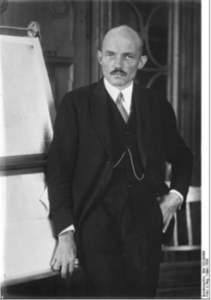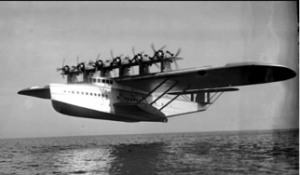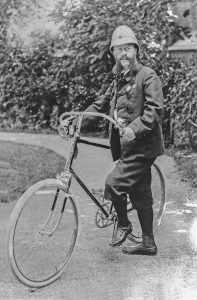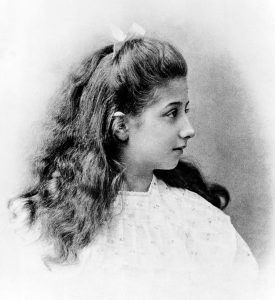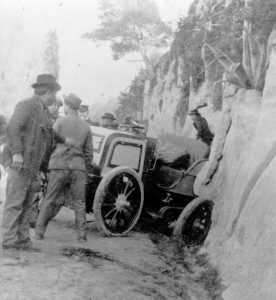On 2nd July 2002, striking images were captured in New York as a helicopter delivered the newly developed Maybach 62 for its world première on Wall Street. On this day, the DaimlerChrysler AG resurrected the legendary automobile brand Maybach, one of the most exclusive German marques of the 20th century. Irmgard Schmid-Maybach, the daughter of Karl Maybach, had the honor of receiving the first production Maybach on 14th October 2002. This vehicle remains in the family’s possession to this day. While the „Myth of Maybach“ has continued to resonate in people’s minds, the new models marked the beginning of a new chapter in German automotive history, one that is set to endure in the future.

On 23rd September 1921, the first production Maybach automobile, the „Type 22⁄70 PS · W3“, was unveiled at the German Automobile Exhibition in Berlin. The vehicle captivated the audience with its high quality and technical features: for the first time, a German automobile was equipped as standard with a four-wheel brake system and could be driven with an automatic transmission. The „W3“ set the benchmarks that Karl Maybach defined in Friedrichshafen for the Maybach brand: meticulous precision, the finest materials, and innovative technology for the utmost driving comfort.
Sixty years after the last Maybach of the SW 42 type was delivered in 1941, the first example of the new Maybach 62 left the Maybach Manufactory in Sindelfingen (Germany) on 24th June 2002. The maiden voyage was destined for New York City, where the car was presented to the global public. In keeping with tradition, the Maybach 62 crossed the Atlantic in a specially constructed glass container aboard the ocean liner Queen Elizabeth II. What many do not know is that the container was placed on a special deck, allowing first-class passengers to be the first to glimpse the new limousine.
Upon arrival in New York, the vehicle was flown by helicopter from the deck of the Queen Elizabeth II to the old Cunard Pier in Manhattan. From there, escorted by the New York motorcycle police, it proceeded to the spectacular world première at the Regent Ballroom next to the New York Stock Exchange. „Never before has a car been presented so spectacularly — A show in Hollywood style,“ wrote the German press. Over 500 million television viewers and more than 350 newspapers worldwide reported on the event — a resounding success. The campaign was planned and executed by Oliver Schrott and his agency OSK.
At the launch in 2002, two limousines were available, with model names reflecting their impressive lengths: 6.17 meters for the Maybach 62 and 5.73 meters for the Maybach 57. Equipped with the latest automotive technology, the new Maybach models embodied the principles that Karl Maybach adhered to while developing legendary vehicles in Friedrichshafen from 1921 to 1941: „Create only the best from the best, of lasting value, in the highest form of perfection.“ This was the philosophy of Karl Maybach and the Maybach Motorenbau GmbH, which aimed to set the standard for the new models in 2002. Additionally, the brand benefited from the technical expertise and experience of Mercedes-Benz in the luxury segment, along with its global network. Many components of the new Maybach models were based on the proven Mercedes S‑Class W 220 and the W 140 series. The specially developed distribution concept included around 25 Maybach centres worldwide, with the „Centre of Excellence“ in Sindelfingen serving as a central hub close to the manufactory. The production of Maybach limousines in the modern Sindelfingen manufactory allowed for the realization of the most exclusive customer wishes. Each handcrafted luxury vehicle became a unique masterpiece, perfectly combining high-tech and craftsmanship.

Vehicle technical developments that had previously only been available exclusively in Mercedes-Benz vehicles were further developed for the Maybach limousines and became standard equipment in all Maybach models. These included the electrohydraulic brake system Sensotronic Brake Control (SBCTM), the AIRMATIC DC air suspension, the LINGUATRONIC voice control system, the COMAND APS control and display system, and the automatic emergency call service TELEAID. As with the Maybach automobiles of the 1920s and 1930s, these technical advancements not only enhanced driving comfort but also significantly improved vehicle safety. DaimlerChrysler also focused on its own innovations that underscored Maybach’s aspiration to lead the luxury segment.
The twelve-cylinder engine with a displacement of 5.5 litres and twin-turbocharging produced 405 kW (550 hp) and offered a maximum torque of 900 Nm at 2300 rpm, making the „Type 12“ engine the most powerful production engine in a limousine worldwide. The Maybach 57 and 62 models could accelerate from 0 to 100 km/h in just 5.2 seconds and reached an electronically limited top speed of 250 km/h. The Maybach 57 S, introduced in 2005, featured a 6.0‑litre V12 twin-turbo engine with 450 kW (612 hp), allowing it to accelerate from 0 to 100 km/h in 5 seconds. Later, Mercedes-AMG developed an even more powerful engine with 471 kW (640 hp), which propelled the Maybach 57 Zeppelin from 0 to 100 km/h in 4.9 seconds and reached a limited top speed of 275 km/h.
The head of development for the new Maybach vehicles was Professor Hermann Gaus. In just three years, he brought the first Maybach vehicle into production. Driven by the desire to create a vehicle of the highest quality, Gaus worked tirelessly from 1999 on the prototypes of the Maybach 57 and Maybach 62. As he himself stated, he always oriented his work around the high standards set by Wilhelm and Karl Maybach, as well as the automotive development at Maybach Motorenbau in Friedrichshafen: „Maybach vehicles of the 1920s and 1930s were characterized by technical innovation, the highest quality, luxurious equipment, and individuality. These qualities were also incorporated into the new Maybach vehicles of the 240 series. However, the realization of these features differs due to the 70 to 80 years of technological advancement in between. A common trait, however, remains the love for detail and perfection in execution.“
Like Karl Maybach, Professor Gaus spared no expense. Test drives took place worldwide to assess the vehicle under various conditions. In Laredo, Texas, the car was exposed to extreme temperatures, while its endurance and durability were evaluated on rough terrains. In Arjeplog, Sweden, the electrohydraulic braking system was tested in icy conditions. Overall, all test vehicles covered 2.5 million kilometres under real-world conditions.
At the end of 2002, Gaus was honoured with the Benz-Daimler-Maybach Award by the Association of German Engineers. From 2007 to 2021, he served as a board member of the Wilhelm and Karl Maybach Foundation, which has resulted in a lasting connection with the Schmid-Maybach family. In a 2020 interview with the Foundation, Gaus spoke about the inspiration he drew from Wilhelm Maybach: „Wilhelm Maybach was a brilliant designer and inventor, rightly referred to as the ‚King of Designers.‘ If a vehicle from DaimlerChrysler AG was to bear the name Maybach, it was clear to everyone involved that it had to be the number one limousine to live up to the name’s prestige.“ You can read the entire interview from 2021 here:
https://maybach.org/zum-85-geburtstag-prof-hermann-gaus/.
In addition to the technical components, the Maybach Manufactory equipped the high-end luxury limousines with a specially developed solar module. Covering an area of approximately half a square metre, 30 solar cells converted sunlight into electrical energy, generating up to 63 watts of power. The solar energy was used to power the air conditioning ventilation fan when the ignition was off, allowing fresh air to circulate within the cabin. This helped reduce the heating of the dashboard, seats, and other interior parts during the summer months.
Exclusively in the Maybach 62, there were reclining seats with a reclining function: the rear passenger could tilt the backrest by up to 47 degrees at the touch of a button and activate a leg rest and footrest. Adjustable air cushions and a massage function enhanced seating comfort. A technical highlight of the Maybach 62 was the innovative electrotransparent panoramic roof. The laminated glass panel contained a liquid crystal film that became transparent under alternating current. Once the current was switched off, the panel became opaque.
All entertainment and communication facilities for discerning travelers were standard onboard, ranging from a DVD player to a wireless telephone. With the Business Package, it was possible to connect a laptop to the vehicle’s computer via Bluetooth, enabling fax sending and receiving as well as internet access — at that time, a novel feature. Starting in 2010, a WLAN router and a Personal Digital Assistant (PDA) became available.
For the body paint, the luxury brand Maybach offered a spectrum of 17 color shades, which could be elegantly combined in two-tone combinations. At the 2007 International Motor Show in Frankfurt, Maybach showcased the ALU BEAM Silver paint, which draped over the body like a liquid metal skin. The safety technology of the Maybach 57 included a meticulously developed body structure and a total of ten airbags — among them large side window airbags on each side of the interior. Notably, the Sensotronic Brake Control (SBCTM) system developed by Mercedes-Benz and the electronically controlled AIRMATIC DC air suspension were also featured. Both systems were interconnected, individually adjusting the damping and braking force based on road conditions, driving style, and vehicle load — truly innovative!
Those who examined the M 57 and M 62 up close discovered an example of the Maybach engineers‘ meticulous attention to detail in the headlights: the lenses of the Bi-Xenon headlights were adorned with the double‑M emblem of the Maybach Manufactory — an original contribution to product identity and a nod to the legendary „Maybach 12 Zeppelin“ from 1930. Additionally, tailored special editions for top-tier hospitality were developed, including gold instead of chrome in the interior, gold paint on the rims, lambskin carpets for a cozy atmosphere, family crests in custom locations, a compass in the headliner, or a partition with a retractable window — customers had the choice. Upon request, the Maybach 62 was also available with a special protection package designed to shield occupants from high-caliber handgun fire, thus meeting the security requirements for high-level protection. After the successful revival of the Maybach automobile brand in 2002, DaimlerChrysler AG realized that the demand was lower than hoped.
Consequently, there were no successor models for several years following the reintroduction. However, at the Dubai Motor Show in 2007, DaimlerChrysler unveiled an extraordinary masterpiece: the prototype of an open Maybach Landaulet. In the tradition of exclusive landaulets, the roof of this shimmering white unique piece could be completely opened in the rear, while remaining closed in the chauffeur’s compartment. When opened, the roof folded down and rested, along with the integrated rear window, on the parcel shelf. The chauffeur could cover the stowed roof with an elegant white leather tonneau cover. In autumn 2008, the prototype of the Landaulet, based on the 62 S, became a reality and was delivered to the first customers. With the Maybach Zeppelin, the brand crowned its model range, marking its peak position in the high-end segment. It was a worthy successor to the legendary Maybach Zeppelin from the 1930s, regarded as the pinnacle of sophisticated automobile manufacturing. Externally, the flagship of the luxury brand was recognizable by a two-tone special paint. The inscription „ZEPPELIN“ arched beneath the double‑M of the bonnet ornament and on the rear lid highlighted the special status of the Maybach Zeppelin. The Maybach Zeppelin was limited to just 100 units worldwide.
Overall, Maybach sold around 3,600 vehicles between 2002 and 2012. A maximum of five Maybach vehicles were produced per day, exclusively made to order at the Maybach Manufactory in Sindelfingen, Germany. Ultimately, the high sales expectations of DaimlerChrysler AG could not be met. In November 2011, Daimler CEO Dieter Zetsche announced that the Maybach brand would be discontinued in 2012 in favor of other models of the Mercedes S‑Class. On 17 December 2012, the last Maybach vehicle left the manufactory. Although Maybach limousines continued to be sold until 2013, the name was to be retired thereafter. Today, those fortunate enough to own one of the élite Maybach vehicles from 2002 to 2013 can consider themselves lucky — the vehicles have become rare, and collector prices are steadily rising. At the end of 2014, the Daimler Group announced the reintroduction of the Maybach brand name.

Even though Karl Maybach was no longer able to produce his rare luxury automobiles after the Second World War, there was a large community of Maybach automobile enthusiasts, centred around the „Maybach Club,“ who collected and lovingly maintained the old Maybachs. When DaimlerChrysler AG revived the myth of Maybach in the form of the Maybach models 57 and 62 in 2002, it was clear to all that a new chapter in German automotive history was being written. To this day, Maybach automobiles continue to be produced, keeping the Maybach legacy alive and meeting the highest standards of quality and technological advancement in automobile manufacturing.














